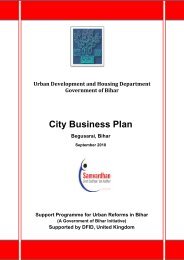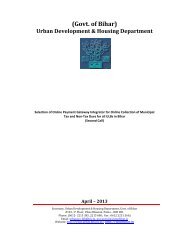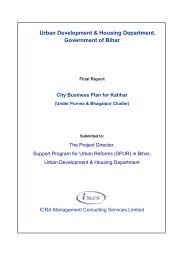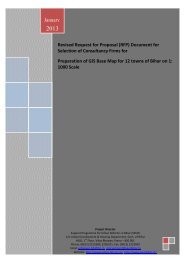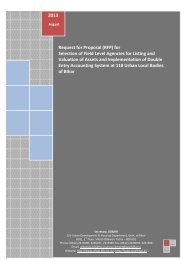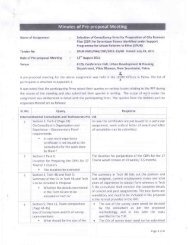CITY BUSINESS PLAN
CITY BUSINESS PLAN
CITY BUSINESS PLAN
You also want an ePaper? Increase the reach of your titles
YUMPU automatically turns print PDFs into web optimized ePapers that Google loves.
1 INTRODUCTION<br />
1.1 Introduction<br />
This chapter explains the contextual and conceptual underpinnings of a City Business Plan (CBP) in<br />
terms of a brief overall status of urban poverty in India, and in Bihar, and the significance of a city<br />
business plan in facilitating a city‟s inclusive economic growth.<br />
1.2 Urban Poverty in India<br />
While India is becoming increasingly urbanised, the country is witnessing a corresponding increase in<br />
the concentration of poor people in urban areas.<br />
As per the latest survey report of the National Statistical Survey Organisation (NSSO) there are over<br />
80 million poor people living in the cities of India. In some of the larger states, the ratio of urban<br />
poverty is higher than that of rural poverty leading to the phenomenon of „Urbanisation of Poverty‟.<br />
Urban poverty poses the problems of housing, water, sanitation, health, education, social security, and<br />
livelihood along with the urgency to address the special needs of vulnerable groups such as women,<br />
children and aged people. In many smaller cities (particularly, towns) with an underdeveloped<br />
industrial and commercial sector, most poor people are involved in informal sector activities where<br />
there is constant threat of eviction and almost non-existent social security cover. With growing<br />
poverty, such Indian cities have been grappling with the challenges of making the cities sustainable,<br />
i.e. inclusive, productive, efficient and manageable.<br />
1.3 Urban Poverty in Bihar<br />
Bihar is the third largest state in terms of total population as per the 2001 census and influx into urban<br />
areas in the state has put urban infrastructure and services under severe stress. The increasing pressure<br />
on the urban environment is taking its toll on the quality of life of the urban population. Further, in<br />
urban areas, more than 59.8% of the household heads are self-employed and only around 30% have<br />
regular employment. While casual wage labour represents only around 10% of occupation among all<br />
urban household heads, in the poorest quintile, the majority of the urban poor has no choice but to<br />
work in this vulnerable sector.<br />
Cities hold tremendous potential as engines of economic and social development, creating jobs, and<br />
generating wealth through economies of scale. They need to be sustained and augmented through high<br />
urban productivity for better economic growth. For cities to become growth oriented and productive it<br />
is also essential to attain efficiency and equity in the delivery and financing of urban infrastructure.<br />
An integrated approach is needed to address various dimensions of urban development. Infrastructure<br />
inadequacies in urban areas are a major factor constraining Bihar‟s growth. The tasks involved in this<br />
regard are to:<br />
Final Report<br />
1-1




